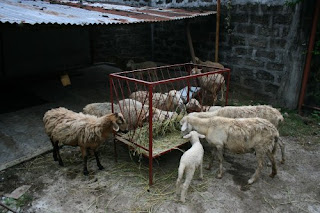just got the article from a website
http://www.agnet.org/library/bc/50003/
Raising of Native Pigs
Location: Philippines
Technical Description
The so-called native or country pigs could have originated from the wild pigs that are still common in the Philippine forests in a few provinces. The native or country pigs are mostly black in color or a mixture of brown and white, with long snouts. They have saddlebacks, scaly skin, and a small to medium body size.
The majority of these animals are raised in the backyard. They are either tethered under the trees or house posts, allowed to roam in the field on a self-supporting basis, or kept in makeshift pens.
Normally the day's ration consists of kitchen refuse or food leftovers, rice bran and an aquatic creeping vegetable locally known as "kangkong" (Ipomea aquatica). Sweet potato (Ipomea batatas) tops and vines and thinly sliced banana pseudostems are also given to the animals. The bran and the kitchen refuse are usually mixed with water to form slop and then fed to the animals. The greens or the chopped pseudostems are given separately in between feeds.
Uses and Merits
Despite the introduction of imported and highly prolific breeds of pigs, demand for and acceptance of native pigs are still very high. Farmers and households in the regions where native pigs are found still prefer this genotype, especially when the pigs are roasted. The native pig is well accepted as a secondary source of income, as food, and for family food security. The maintenance requirement is relatively low and the breed is quite resistant to natural elements and diseases. In the Philippines, the suckling or weanling native pigs are very well accepted and preferred for roasting, and are locally known as "lechon." Usually the roasting stick is bamboo.
Reservations on Its Use
The raising and production of native pigs have been limited to backyard operations with very little investment and minimal improved practices extended. Compared to the improved and modern breeds, the native pig is known to be a genetically slow grower and the production and reproduction coefficients are also low.
Since the native pigs are allowed to roam and scavenge in the field along shores and in garbage, they can easily pick up parasites and microorganisms and serve as effective carriers of diseases, which could infect other animals including man.
Expert's Comments
Despite the reservations on the production of native pigs, this genotype carries the genes for adaptability and resistance. These traits could be used in the future for local breeding works. Earlier researches have shown that with good selection of breeders, the performance of the native pigs improved significantly, despite low inputs made in management and technology used.
Friday, February 20, 2009
Thursday, February 12, 2009
RAISING SHEEP in The Philippines

sheep raising is not as popular here as goats,cattle and carabaos/buffalos. we have a yahoo.goups here about sheep but i thinks the members are only 6 in numbers. sheep here are bred for meat and not for wool. the only book i had about sheep is Storey's guide to raising sheep by Paula Simmons and Carol Ekarius. ive searced almost all big bookstore here for more sheep books but found none.So i just rely on the internet for more infos about sheep.my love for sheep started 2 years ago when my cousin bring a pair of sheep here in the farm,he needs money he said. i bought the sheep and let it mingle with my goats they stayed in my goarhouse. their first lamb died and then the ram. so i am left with the ewe. luckily she gave birth to a lamb. then a friend from tarlac exchange an extra ram of his for a native pig, he just breed 2 ewes and a ram for his personal use. then a friend told me last june 2008 that he had a neigbor who raises sheep. the next day i went to the place, its a cattle fattening farm. i saw about 30 sheeps mixed ram,ewes and lambs. i went hone with 2 ewes paying double the price of my first sheep. luckily after a week one of the ewes gave birth to a lamb and i think the other one is pregnant.
 as of now i have a ram, 8ewes and 7 lambs. twice a day i go to them and look at them. thinking that i would be a shepherd one day. ill have a wooden stick and a dog and tend to my sheeps. beacuse ill be breeding sheep for their meat. ill be looking for characteristics like good mothering ability, easy lambing, twinning, good feed conversion, growthy lambs and hardy stocks. maybe in the near future when i attain the 11 ews that i want i'll learn to process their wool as my hobby.
as of now i have a ram, 8ewes and 7 lambs. twice a day i go to them and look at them. thinking that i would be a shepherd one day. ill have a wooden stick and a dog and tend to my sheeps. beacuse ill be breeding sheep for their meat. ill be looking for characteristics like good mothering ability, easy lambing, twinning, good feed conversion, growthy lambs and hardy stocks. maybe in the near future when i attain the 11 ews that i want i'll learn to process their wool as my hobby.
6 years ago i raised goats and theres a difference between them and sheep. the book i read and internet infos i gather applies mostly to 4 season countries.but the basics really help me a lot. if anyone in the Philippines read this blog and into sheep raising please contact me.and lets have a chat.

for video see the link:
Subscribe to:
Comments (Atom)
